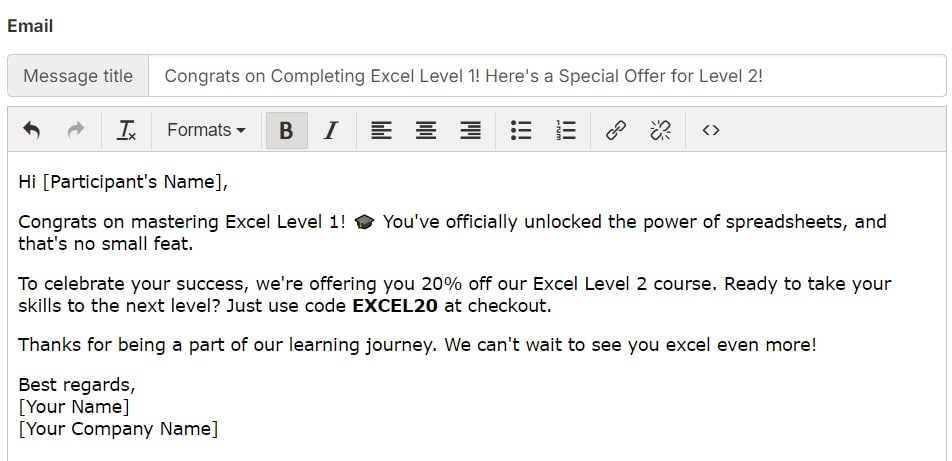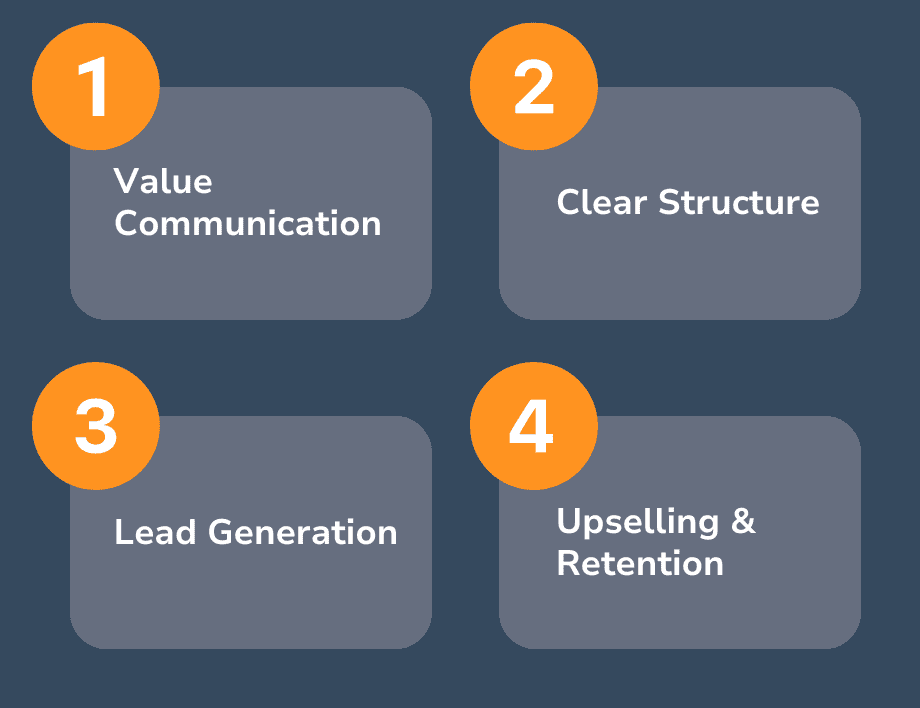After you have created your online course, it is time to sell it. This might seem like a piece of cake, but there are actually some pitfalls to avoid and some best practices to follow. Wondering how to sell training courses effectively? Continue reading to explore proven strategies for selling your online training course and ensuring a recurring revenue stream for your business.
10 steps to follow when you want to sell online training courses
1. Create a buyer journey
Selling your training successfully requires that the client is aware of their needs and that they know they have a problem, in addition to having considerations of various solutions to that problem. Most likely they are prepared to make a decision, meaning that simply needs a push to commit to your course. In summary, their awareness, consideration and decision making must be aligned, which you can influence in your marketing strategy.
2. Define and promote your USPs
When you sell training courses, you must make it clear for the potential customer what makes you different from anyone else on the market. You need to define your Unique Selling Proposition (USP), which is the potential output of your product. Which knowledge or insights does your customer get when subscribing to your course catalogue?
You should consider whether your course is:
- Improving their internal structures
- Improving their knowledge or skills, or teaching them something new
- Providing or facilitating a career boost, either in terms of promotion or pay raise
- Offering them benefits that impact or improve their personal life or quality of life
These benefits should be crystal clear in your marketing strategy and should be evident on your website, in social media promotion, or other marketing materials.
3. Decide price
Pricing your course is a crucial factor for selling courses online and how attractive your course offer is for customers. Course pricing impacts if people can afford it, if they perceive that the price and offer is aligned, and that they feel like they get the proportionate value from the course price.
Pricing is impacted by:
- Course content
- Competitive landscape
- Impact
- Market demand
- Credibility and authority
Remember that the price is not fixed, meaning you can test, experiment, discount and change it.
Tips! You can also implement an alternative pricing structure, like a recurring subscription, payment plans or a buy-now-pay-later-structure.
4. Create course landing page
Your website and landing page for the course offer is the foundation for your course business. This is the destination where future customers come to explore your offer and consider and decide whether to buy your course.
The landing page should include:
- Attractive headlines and headers
- String action words and a general language that promotes action
- Engaging media, including images and videos that demonstrate the course offer in action
- Testimonials and reviews from former and existing customers
- The offer, either price or discount, very clearly visible
- Payment forms and sign-up
5. Choose the correct online course marketplace or platform
You need to find the right place to sell your course. Oftentimes, you need access to a platform where you can build courses and implement the course structure you find most suitable for your participants. By choosing the right course platform, you are making it easier to implement the business strategy correctly. Consider cost, hosting options, scalability and features when you decide on a course platform.
You have three different options when it comes to where to sell your courses:
- Online course platforms: Designed to help educators build and grow online course businesses.
- Self-hosted online course website: Create a personal website where you integrate the course offer and sell your course catalogue without a third party.
- Online course marketplace: Add your course catalogue to a course marketplace, where potential customers can find your courses.
Take advantage of a learning management system
You can take full advantage of a learning management system (LMS) when you are selling your online course. This is a learning platform where you can design and organise digital learning sessions, which facilitate online courses. A LMS enables you to create a virtual online sphere for training and learning, which gives you the ability to offer your colleagues flexible training sessions.
6. Make the course accessible to people
It is important to make the course affordable. This will make it easier to sell your training and it will make it more accessible for more people. A reasonable price will increase the chances of customers actually buying the course. Having said that, it is important not to price it too low, as the value of knowledge is hard to calculate. The pricing is a direct message of how valuable your knowledge is.
7. Promote the course while increasing the value of it
You can do organic promotion on social media channels, ask customers what they think about your course, and do cross-promotion on Instagram and LinkedIn. Build a community and promote the course catalogue by engaging former and existing customers.
At the same time, you should apply some strategies to increase the value of the course.
- Create a limited offer: Make an offer they cannot refuse and add time limitation to it and create a sense of urgency to purchase it. This also helps sell your training.
- Provide premium content: Exclusive content like downloadable content or bonus lectures, is a way to increase engagement and satisfaction.
- Make and sell course bundles: Much like a limited offer will do, a bundle offer will encourage people to purchase more courses. They see the context and value of taking three courses back to back.
Quick tip! You should implement a three-tiered pricing structure, where you offer one tier with the normal price and the next two tiers with enhanced features and higher price. People will choose the cheaper one, which is perceived as the best deal.
8. Market the course
Promotion is not enough if you want to sell your courses to a broader audience. Therefore, you need to design and implement a marketing strategy that propels your course business to a broader audience. But you want to reach the correct potential customers, which is determined by which marketing channels you choose.
Interested in which methods will garner the most leads? Read our best advice on how to market an online course.
9. Sell the course
Now it is time to sell the course. Make it easy to complete the purchase and access the course. You want to build trust and ensure that your customers get the expected results from choosing your course catalogue. You want to make sure that they are satisfied. Therefore, it is a good idea to gather feedback from them and use this information to improve and expand your course offerings.
10. Upsell afterwards!
Use your expertise and expansive course catalogue to offer customers something else when they finish their course. A free one-on-one coaching session or exclusive access to upcoming content will heighten the experiences and make them perceive the course catalogue as even more valuable. Make sure that is personalised to them. A tailored offer increases satisfaction and makes them more receptive to other deals. When they experience that you take their personal needs seriously, they will gain trust in you.

Example of an upsell email using FrontCore TMS: Encourage further learning with a special discount offer.
The foundation: How to sell training courses
The key thing to selling an online course is communicating to the customer that you have a high quality digital product with great potential. Therefore, it is important to put a lot of effort into creating your online course. A course worth buying, is a course worth selling. You need to choose a topic, create your course tailored to your target audience, and explore options for how you can continuously improve and expand your course catalogue.
A relevant topic
The most important element to a successful course, is that you are contributing proactively and positively to a demand. But how do I respond to a demand, you ask? You pick a relevant topic that you know people want to delve into or that is not being sufficiently covered on the market today. If you choose a relevant topic, you have a good foundation for gaining a sustainable pool of potential customers, which you can sell your course to.
Steps to consider before selling your course
You need to invest time and money when creating your course. It is imperative that your course offer is attractive to customers, which is why you need to spend some time planning and developing your course catalogue. When you have credibility and display authority, your offer will have value for many businesses.
- Choose topic
- Create course
- Decide price and build course sales funnel
- Create course landing page
- Do promotion and implement marketing strategies
- Sell the course
Customers meet in the course sales funnel
The sales funnel is the process of guiding potential customers through the steps before they buy your product. The sales funnel is necessary to have in consideration when it comes to selling your training. It convinces the customer that your course is worth the investment, both in terms of the financial aspects and the potential knowledge or skills gains.
The sales funnel should consist of a few key stages:
- Ensure that the offer is attractive and that you communicate the value for money they get. Present the price at the same time as you explain the USPs and course design.
- It is important that your website structure, including the landing page for the course offer or catalogue, is easy to understand.
- You must have a defined marketing strategy by using tools to gain leads and attention.
- You should have a sequence for upselling and ensuring that customers become recurring clients.
After you sell a course
Keep your customers happy, listen to their needs and feedback, and continuously improve your course catalogue. When you know how to sell your course, you can always amend your methods to ensure that both you and your customers get maximum benefit. Offer additional courses, services or add-ons, which help them close their skills gaps while also providing you with positive reviews or organic referrals.
Concluding tips for selling your course
Now you know the process of how to sell your online course step-by-step. But we want to underline a few steps that are essential to running a successful online course business.
1. Build trust
Trustworthiness is key to success. Customers will only use your course offer if they trust you, and like the saying goes, trust is earned over time. Therefore, you must put in the effort to establish trust between you and your target audience. Build loyalty and convince them to invest in your course offer, which you achieve by being transparent and explaining your ethos and the potential benefits of your course offer.
Tip! Use social proof like reviews and testimonials from existing customers, and share those on your social media. A robust social media following will do wonders for your engagement.
2. Make the courses accessible
It must be easy to enroll and purchase your course, which is why it is essential to use a training management system (TMS) that you can link to your website and course business. The TMS will handle all sign-ups and make it easier for you to explain the course offer and provide details for the course program.
Try the FrontCore Training Management System today
3. Gather feedback
Your business will never reach the next level unless you are proactive in developing and improving your course offer. One sure fire way to find the ways to improve is to gather feedback from your customers and course participants. By using feedback forms or course evaluation forms, you can easily identify the gaps in your course offer. Get insights into what needs to be improved, altered, or replaced by something else.
Did you like this article? Don't forget to share it:








0 Comments